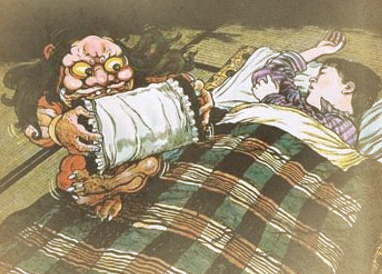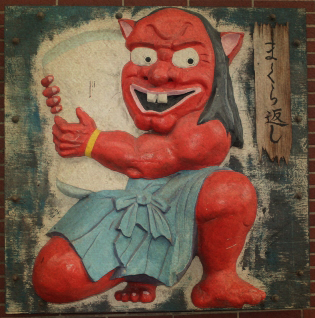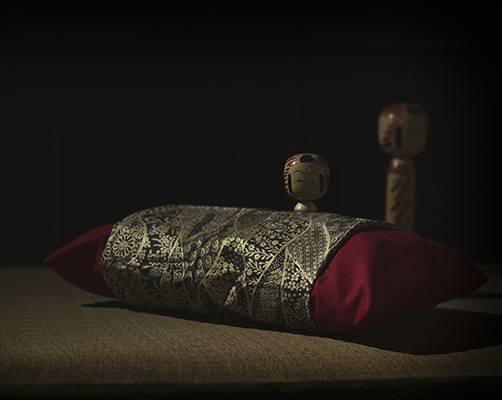Composed by Gregory P. Richards
Suggested arrangement: 1 odaiko, 1 shimedaiko, 2-4 chudaiko, 1 okedo (slung)
Download zip file of Makura-gaeshi sheet music

The Makura-gaeshi is a mischievous yokai, or Japanese demon, that appears in various tales of Japanese folklore. Its name means “pillow flipper,” and true to its moniker, it is known to hide in bedrooms, waiting until the occupants are asleep in bed, then steal the sleepers’ pillows from under their heads and replace them at their feet.
Matthew Meyer of yokai.com says of the makura-gaeshi, “Makura-gaeshi are a kind of zashiki-warashi: a child ghost which haunts specific rooms of a house. They are found all over Japan, though details about them vary from region to region. They take the form of a small child dressed as a Niō, a monk, or a samurai, and appear in bedrooms late at night…While most stories about makura-gaeshi present them as harmless pranksters, there are a few stories that describe scarier powers. Some don’t flip the pillow, but lift up and flip people instead. Others pick up entire tatami mats that people are sleeping on and bounce them around. Still others are said to sit on their victim’s chest while he or she sleeps, pressing down hard and squeezing the wind out of the lung. They occasionally cause kanashibari, or sleep paralysis. The most extreme stories say that anyone who sees a makura-gaeshi loses consciousness, after which the makura-gaeshi steals their soul, leaving them dead.”

Horror manga artist Shigeru Mizuki, known for his yokai-themed manga GeGeGe no Kitaro, adds an extra element on to the makura-gaeshi by giving them two brains: one for thinking up pranks, and the other solely dedicated to creating rainbows that the yokai can shoot out of its eyes.
Greg Richards’ take on the makura-gaeshi legend combines these myriad elements into a composition showcasing the many talents of this versatile yokai.
COMPOSITION
Makura-gaeshi consists of 5 main themes (labeled A-E). ShinDaiko’s original arrangement calls for 1-2 players on each of the two chu parts, 1 player switching between shime and odaiko, and 1 lead player on slung okedo who also plays the part of the makura-gaeshi.
These main themes are meant to act as a general framework for the song. Feel free to add, modify, and re-arrange to create your own unique makura-gaeshi!
NOTES ON MASK AND WIG: As far as we know, there are no commercially available masks that look like the makura-gaeshi, so unless you would like to custom order or 3D print a makura-gaeshi mask, there is a limited selection out there. The mask that we use is a generic oni mask. Oni masks can be bought from myriad places online; ours is a heavier-duty plastic mask made specifically for paintball players similar to this one. The wig is a separate piece from the mask, and any long wig should be just fine.
THEME A: “Kids Playing”
(4/4 time) Part A is played with a boisterous feel, simulating young kids at play. The excerpt demonstrated in the video below is the first measure of a two-measure line. This first measure is consistently the same throughout; the second measure is variations on the theme.
THEME B: “Sleeping”
(5/4 time) Part B is meant to resemble snoring noises, played by sliding the tip of your bachi from the bottom to top of the drum.
THEME C: “Pillow Flipping”
(5/4 time) Part C, played by the slung okedo player, is layered over the snoring noises of B. At various intervals during C, the okedo player will “flip the pillows” of the other players as they slowly drop out, leaving the okedo playing alone.
THEME D: “Soul Stealing”
(4/4 time) The okedo player “controls” the chu players by layering Chu part 1 and then Chu part 2 back in one by one. Meanwhile, the shime player is also “controlled” and switches from shime to odaiko, freeing up the shime for the okedo player. To demonstrate the shime player being under the makura-gaeshi’s spell, use a stumbling/lurching movement to move backwards from the shime to the odaiko.
THEME E: “Rainbow Shooting”
(4/4 time) The grand finale.
This composition is open-source, meaning that you are free to take it, learn it, modify it, and perform it however and whenever you wish. We do ask that you give credit to ShinDaiko and Greg Richards, the composer, when possible. Happy drumming!
